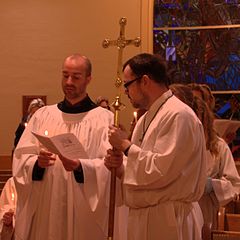| Candlemas | |
|---|---|
 Blessing of candles on Candlemas at an American church | |
| Also called |
|
| Observed by | Christians |
| Significance | Commemoration of the presentation of Jesus at the Temple |
| Observances |
|
| Date | 2 February |
| Next time | 2 February 2025 |
| Frequency | Annual |
| Related to | |
Candlemas, also known as the Feast of the Presentation of Jesus Christ, the Feast of the Purification of the Blessed Virgin Mary, or the Feast of the Holy Encounter, is a Christian feast day commemorating the presentation of Jesus at the Temple by Joseph and Mary. It is based upon the account of the presentation of Jesus in Luke 2:22–40. According to the Old Testament rules in Leviticus 12, a woman was to be purified by presenting a lamb as a burnt offering, and either a young pigeon or dove as sin offering, 33 days after a boy's circumcision. The feast falls on 2 February, which is traditionally the 40th day of and the conclusion of the Christmas–Epiphany season.[1]
While it is customary for Christians in some countries to remove their Christmas decorations on Twelfth Night (Epiphany Eve),[2] those in other Christian countries historically remove them after Candlemas.[3][4] On Candlemas, many Christians (especially Catholics, Eastern Orthodox, and some mainline Protestant denominations including Lutherans, Anglicans and Methodists) also take their candles to their local church, where they are blessed and then used for the rest of the year;[5][6] for Christians, these blessed candles serve as a symbol of Jesus Christ, who is the Light of the World.[7]
- ^ Knecht, Friedrich Justus (1910). A Practical Commentary on Holy Scripture. B. Herder. p. 410. Retrieved 27 December 2016.
We keep a feast on the 2nd of February, forty days after Christmas, in memory of our Lord's Presentation in the Temple. This feast has several names. First, it is known as the Feast of the Presentation of our Lord Jesus. Secondly, it is called the Feast of the Purification of the Blessed Virgin Mary. But the usual and popular name for this Feast is Candlemas-day, because on this day candles are blessed before Mass, and there takes place a procession with lighted candles. Candles are blessed and lighted on this particular feast.
- ^ A Study Guide for William Shakespeare's "Twelfth Night" (2nd ed.). Cengage Learning. 2016. p. 29. ISBN 9781410361349.
Twelfth Night saw people feasting and taking down Christmas decorations.
- ^ Edworthy, Niall (2008). The Curious World of Christmas. Penguin Group. p. 83. ISBN 9780399534577.
The time-honoured epoch for taking down Christmas decorations from Church and house in Candlemas Day, February 2nd...Candlemas in old times represented the end of the Christmas holidays, which, when 'fine old leisure' reigned, were far longer than they are now.
- ^ Roud, Steve (31 January 2008). The English Year. Penguin Books Limited. p. 690. ISBN 9780141919270.
As indicated in Herrick's poem, quoted above, in the mid seventeenth century Christmas decorations were expected to stay in place until Candlemas (2 February), and this remained the norm until the nineteenth century.
- ^ Hothersall, Barbara. "Candlemas – Festival of Light". Fulwood Methodist Church Magazine. Retrieved 27 December 2016.
In some countries special candles are brought along to the blessing by the worshippers. These are often very elaborate and are highly treasured. Afterwards they are taken home and kept to be lighted at times of stress – during storms, in sickrooms and at the bedside of the dying.
- ^ Pappas, Christopher A. (18 January 2012). "Ecumenical Candlemas (Feast of the Presentation)". Holy Trinity Anglican Church. Archived from the original on 10 January 2019. Retrieved 27 December 2016.
- ^ Mazar, Peter (6 March 2015). To Crown the Year: Decorating the Church Through the Seasons (2nd ed.). Liturgy Training Publications. p. 253. ISBN 9781618331328.